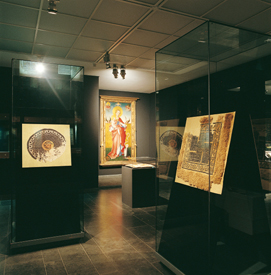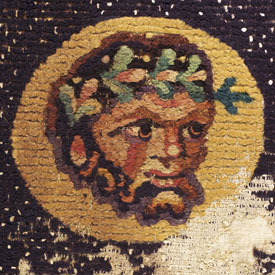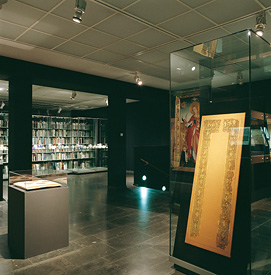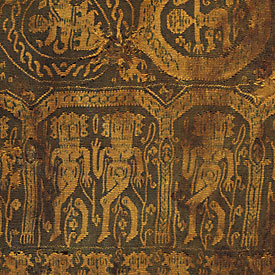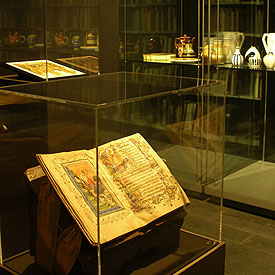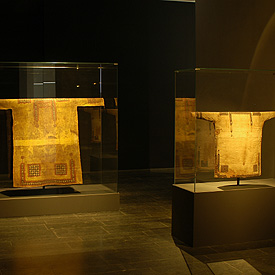2005 Coptic Textiles
18 February to 21 August 2005
Coptic Textiles
Stars for Kolumba – Part 8
»There are lions, panthers, bears and bulls and dogs, forests and rocks, hunters and entire depictions of painted nature. In fact, it seems that painting not only adorns the houses and walls of these people but also decorates their clothes and garments.« At the beginning of the 5th century Asterius, bishop of Amasea, called for simplicity when painting an impressive picture of extravagance and effect of his contemporaries’ clothes. Now and then one might see depictions of holy stories of the Gospel making the wearer believe that he was pious as well as pleasing in the sight of God. Kolumba now presents its small but exquisite collection of Coptic textiles from Egypt, dating from the 3rd to 9th centuries. It is also dominated by Antique figural, floral and geometrical motifs functioning as ornaments for tunics, cloths, cloaks and cushions and thereby displaying the rich pictorial repertoire and colourfulness of cloths and textile furnishing. Fauna and Flora of the Nile, motifs of hunts and animal fights, a satyr, centaurs and cupids as well as maenads and dancers from the wake of Dionysos are the motifs which, isolated from larger scenes, are arranged into new compositions in varying as well as repeating order. They evoke images of a bucolic, paradisical idyll with ideas of wealth and abundance as of the drama of hunt, animal fights and finally of the ecstatic parades of Dionysic feasts. In the course of excavations for treasures of the Pharaohs more recent textiles and other items from the first centuries A.D. were discovered in buried houses and graves which led to extremely successful excavations toward the end of the 19th and the beginning of the 20th century. In most cases the discoveries were cut up at once by the excavators who left the plain and self-coloured textiles and concentrated instead on the decorative parts. Because of this all collections of Coptic textiles look like collections of textile fragments. With the generous support of the Renate König Foundation Kolumba’s Coptic textiles have now been completely restored and exhibited for the first time.
(Book publication)
Coptic Textiles
Stars for Kolumba – Part 8
»There are lions, panthers, bears and bulls and dogs, forests and rocks, hunters and entire depictions of painted nature. In fact, it seems that painting not only adorns the houses and walls of these people but also decorates their clothes and garments.« At the beginning of the 5th century Asterius, bishop of Amasea, called for simplicity when painting an impressive picture of extravagance and effect of his contemporaries’ clothes. Now and then one might see depictions of holy stories of the Gospel making the wearer believe that he was pious as well as pleasing in the sight of God. Kolumba now presents its small but exquisite collection of Coptic textiles from Egypt, dating from the 3rd to 9th centuries. It is also dominated by Antique figural, floral and geometrical motifs functioning as ornaments for tunics, cloths, cloaks and cushions and thereby displaying the rich pictorial repertoire and colourfulness of cloths and textile furnishing. Fauna and Flora of the Nile, motifs of hunts and animal fights, a satyr, centaurs and cupids as well as maenads and dancers from the wake of Dionysos are the motifs which, isolated from larger scenes, are arranged into new compositions in varying as well as repeating order. They evoke images of a bucolic, paradisical idyll with ideas of wealth and abundance as of the drama of hunt, animal fights and finally of the ecstatic parades of Dionysic feasts. In the course of excavations for treasures of the Pharaohs more recent textiles and other items from the first centuries A.D. were discovered in buried houses and graves which led to extremely successful excavations toward the end of the 19th and the beginning of the 20th century. In most cases the discoveries were cut up at once by the excavators who left the plain and self-coloured textiles and concentrated instead on the decorative parts. Because of this all collections of Coptic textiles look like collections of textile fragments. With the generous support of the Renate König Foundation Kolumba’s Coptic textiles have now been completely restored and exhibited for the first time.
(Book publication)
